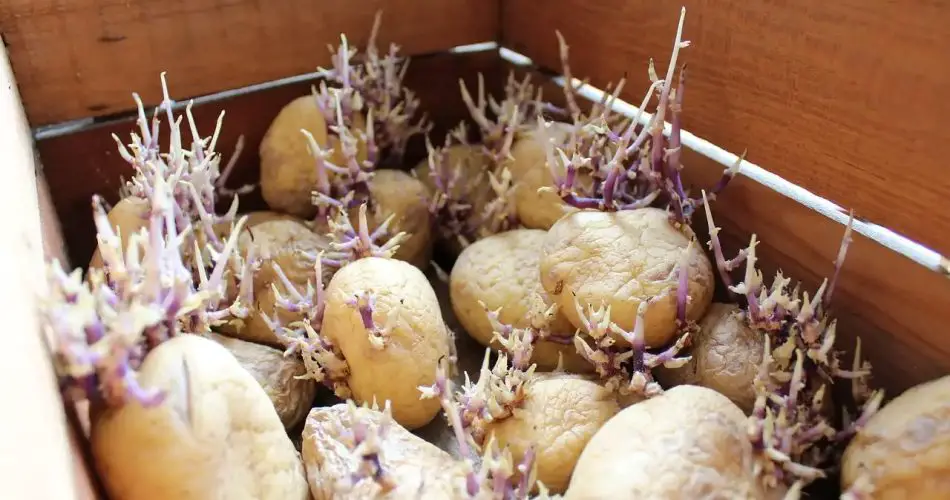Learn the best methods to keep potatoes fresh and extend their shelf life. Follow these straightforward tips to prevent sprouting and minimize food waste.
Maintaining the freshness of potatoes and preventing them from sprouting can seem challenging, but it’s achievable with the right techniques. Here’s your guide to effective and safe potato storage.
Potatoes are a kitchen staple, yet storing them correctly can be complex. Sprouting not only detracts from their appeal but can also diminish their nutritional value. Fortunately, there’s a simple and natural solution to prevent potatoes from sprouting: proper storage and a fresh apple. This article will guide you through the process step-by-step.
Potato Storage: The Secret to Freshness
Proper storage is crucial to keep potatoes fresh and sprout-free. Store potatoes in a cool, dark, and well-ventilated area. The optimal temperature for potato storage is between 4°C and 10°C. Avoid storing potatoes in the fridge, as low temperatures can convert their starch into sugar, affecting their taste and texture.
Another critical aspect is humidity. Potatoes should be kept in a dry environment to prevent mold. Storing them in paper bags or cardboard boxes can help maintain the right ventilation and manage humidity levels. Avoid plastic bags, which can trap moisture and promote mold growth.
A useful tip to halt potato sprouting is to place a fresh apple among the potatoes. Apples emit ethylene, a natural gas that inhibits sprouting. By including an apple in your potato storage, you can significantly reduce sprout development and maintain freshness longer.
Regularly inspect your potatoes for any signs of sprouting or decay. Check them weekly and promptly remove any that appear spoiled to prevent the spread of rot.
Practical Steps to Keep Potatoes Fresh Without Sprouts
For effective potato storage and sprout prevention, adhere to these guidelines. These tips will help your potatoes stay fresh and last longer.
Select the Right Location
It’s crucial to store potatoes in a cool, dark, well-ventilated area. Find a suitable spot in your kitchen or pantry that meets these conditions. Avoid exposure to direct sunlight, which can induce the formation of solanine, a toxic substance that turns potatoes green and bitter.
Choose the Appropriate Container
Opt for a paper bag or cardboard box for storing potatoes. These materials ensure good air circulation and help keep the potatoes dry. Steer clear of plastic bags, as they retain moisture and foster mold growth.
Incorporate an Apple
Place a fresh apple among the potatoes. The apple releases ethylene gas, which helps inhibit the sprouting of potatoes. This simple trick can enhance the longevity of your potatoes and minimize sprouting.
Conduct Regular Checks
Weekly inspections of your potatoes for sprouting or decay are essential. Remove any that show signs of spoilage immediately to prevent them from affecting the rest.
Detailed Guidelines for Potato Preservation
Select Dry, Undamaged Potatoes: Choose potatoes that are dry and free from cuts or bruises. Damaged or moist potatoes can hasten sprouting and decay.
Use a Paper Bag or Cardboard Box: Store your potatoes in a paper bag or cardboard box. Avoid plastic bags.
Add a Fresh Apple: Place a fresh apple with the potatoes. Apples emit ethylene gas, which prevents sprouting.
Identify the Ideal Storage Location: Keep potatoes in a cool, dark, well-ventilated area. The ideal temperature range is between 4°C and 10°C.
Perform Regular Checks: Inspect your potatoes weekly and discard any that show signs of spoilage.
Alternative Methods for Potato Preservation
Besides the apple technique, there are other strategies to preserve potatoes and prevent sprouting. These methods can be combined with the apple trick for optimal potato storage.
Refrigerator Storage: While not ideal for long durations, refrigerating potatoes can be a temporary solution if no other options are available. Remember that cold temperatures can convert starches into sugars, altering the flavor of the potatoes.
Cellar Storage: If you have access to a cool, dark cellar, it’s an excellent place for storing potatoes. Cellars provide stable temperatures and a dark environment, ideal for preventing sprouting.
Sand or Sawdust Storage: Traditionally, potatoes can be stored in dry sand or sawdust. This method helps keep the potatoes dry and well ventilated, preventing sprouting.
Preparing Potatoes for Storage
Clean Potatoes: Remove any dirt from the potatoes, but avoid washing them before storage, as moisture can promote decay.
Allow to Dry: If the potatoes are damp, let them air dry for a few hours before storage.
Inspect for Damage: Discard any potatoes that are damaged or show signs of decay.
Additional Tips for Storing Potatoes
Adopt these storage practices to ensure your potatoes remain fresh and free from sprouts, thereby extending their shelf life and reducing food waste.
Use Orderly: Employ the “first in, first out” method—use older potatoes first and save newer ones for later.
Shield from Light: Store potatoes in a dark environment to prevent solanine formation.
Avoid Washing Before Storage: Keep potatoes dry. Only wash them before use.
Ensure Ventilation: Ensure that the storage container allows for adequate air circulation. Poor ventilation can increase humidity and promote mold growth.
By implementing these tips and using the apple trick, you can effectively preserve potatoes and prevent sprouting. This allows you to always have fresh potatoes ready for your favorite recipes and helps reduce food waste.



